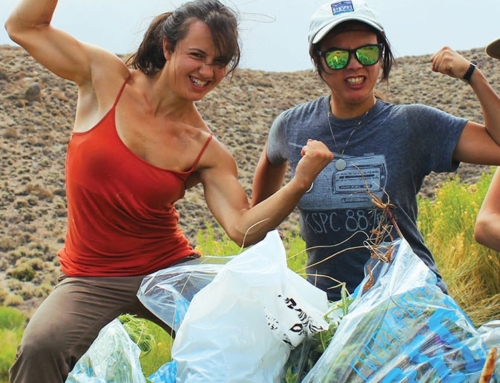
A mule deer doe dashes across a road. © Joe Riis
Stand by Highway 395 today, and two minutes may go by without the roar and burst of breeze from a passing car. California issued stay-at-home orders to stop the spread of coronavirus this spring, during what happened to be peak mule deer migration season. That means that for the first time in decades, the Round Valley mule deer herd may have had a safer spring migration than usual.
But even with reduced traffic, this herd’s migration pathway is treacherous. Each spring and fall, the mule deer make their way through a narrow bottleneck, with Wheeler Crest rising dramatically on one side, Owens River Gorge dropping off on the other, and Highway 395 running in between.
The tragic truth is that each season, many of these mule deer never make it to their destination. On their way up to cooler mountain meadows for summer, or on their way down to their valley homes for winter, their lives are claimed by cars hurtling along the highway.
People are negatively affected by these accidents too. According to a 2017 study by the Road Ecology Center at UC Davis, the total annual cost of wildlife-vehicle collisions in California is at least $276 million, and increases each year. In Mono County alone, nearly 2,000 mule deer from the Round Valley and Casa Diablo herds were killed by vehicles between 2002 and 2015, according to a 2016 CalTrans study. And this number still doesn’t take into account near-collisions with deer, which can result in vehicle collisions if a driver swerves or loses control.
When we compare that number 2,000 mule deer killed in a little over a decade to the fact that the Round Valley mule deer herd is made up of only about 2,400 deer, we start to understand just how big a threat Highway 395 is to the herd’s survival. It’s true that roads affect all wildlife, but this situation is unique; Highway 395 has an outsize effect on this herd due to its placement in the migration pathway.
In all of CalTrans’s District 9, which includes Mono, Inyo, and eastern Kern counties, 93% of the documented wildlife killed by vehicles were deer. And during the same time that 2,000 deer were killed by vehicles in Mono County, only a couple hundred were killed by vehicles in all of Inyo and eastern Kern Counties. CalTrans’s study showed that 91% of deer-vehicle collisions between 2002 and 2015 occurred in Mono County, at very predictable locations where the deer migrate.
But there’s good news. This predictability means a solution may exist. And that same 2016 Caltrans study was a step in the right direction. Local authorities are considering solutions.

Pronghorn cross a wildlife overpass. © Mark Gocke
The 2016 CalTrans study looked into just where the deer-vehicle collisions were happening. They found key “hot spots” around one area: a six-mile-long segment stretching south on Highway 395 from Highway 203 to near Benton Crossing Road. It looked into past attempts to keep the deer safe, including fences and strategically-placed warning signs for drivers neither of which were effective at reducing collisions. After its thorough review of research and case studies, the study concluded that an integrated system of funneling fences with overpasses and underpasses could be the solution. Such a strategy could reduce deer-vehicle collisions by 90% or more.

© Tom Koerner, USFWS
Overpasses and underpasses for wildlife have seen powerful positive effects like this all over the country and world. They cost money to install, but when they are put in place, they dramatically cut costs from vehicle damage and human injury that result from accidents. That’s why, wildlife-lovers or not, most citizens are in support of the crossings. Wildlife crossings have been constructed in diverse areas throughout the West, from Los Angeles to Wyoming. A Pew survey found that 93% of Nevadans across political and socioeconomic spectrums are in favor of man-made crossings for wildlife like overpasses and underpasses. CalTrans’s 2016 study showed that such a project could make a big positive difference for both people and mule deer in the Eastern Sierra.
ESLT is part of the Eastern Sierra Wildlife Stewardship Team led by Mono County. Together, this team is evaluating strategies like these that could lower the risk of wildlife-vehicle collisions on Highway 395. We hope to one day soon make our local highways safer both for humans and for wildlife like mule deer, black bear, sage-grouse, and more.






